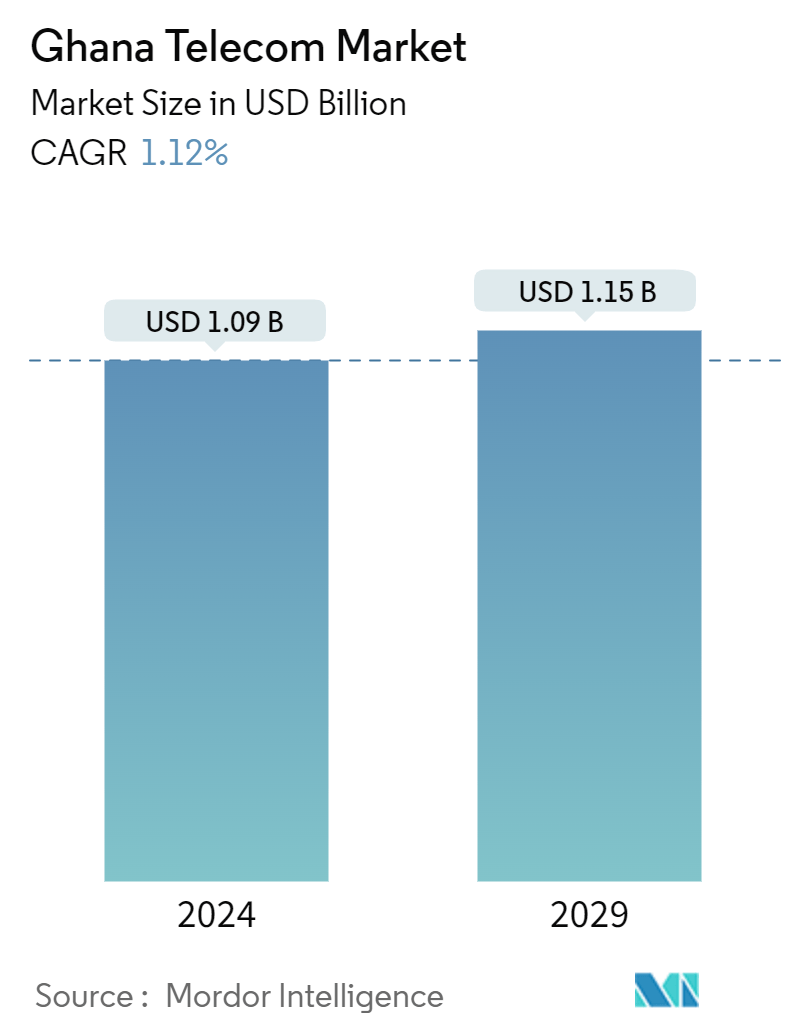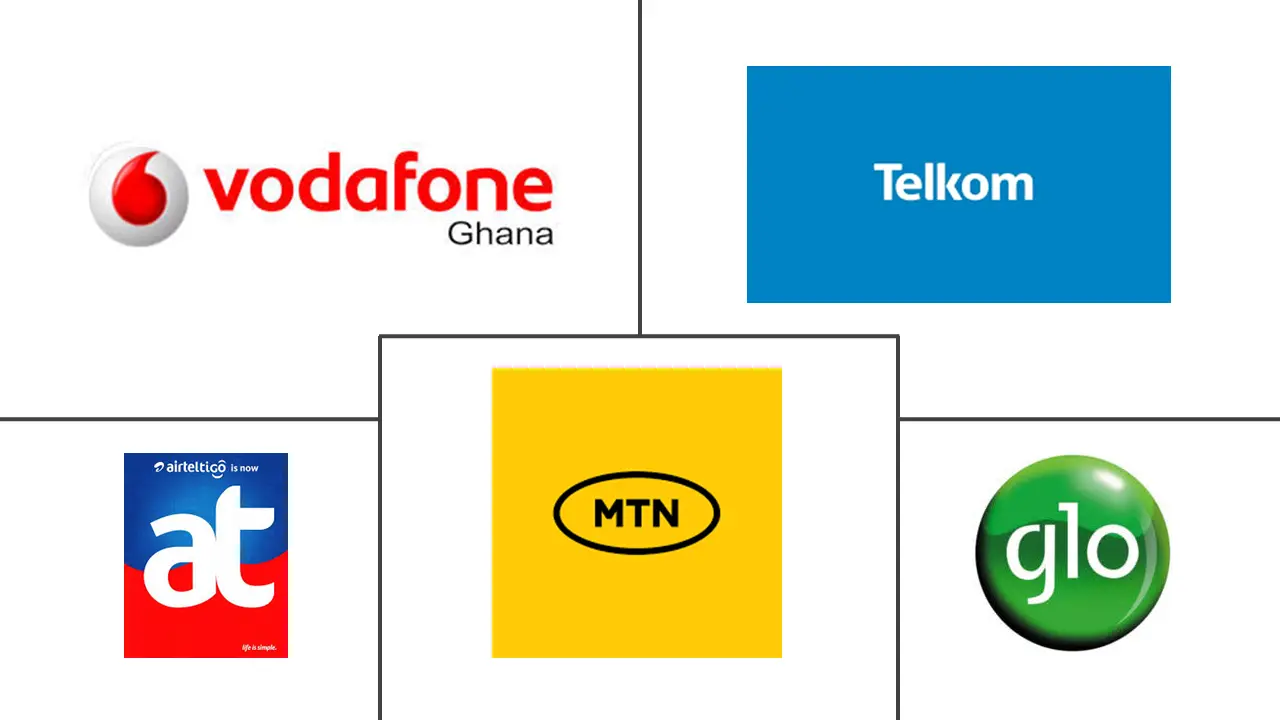Market Size of Ghana Telecom Industry

| Study Period | 2019 - 2029 |
| Base Year For Estimation | 2023 |
| Market Size (2024) | USD 1.09 Billion |
| Market Size (2029) | USD 1.15 Billion |
| CAGR (2024 - 2029) | 1.12 % |
| Market Concentration | High |
Major Players
*Disclaimer: Major Players sorted in no particular order |
Ghana Telecom Market Analysis
The Ghana Telecom Market size is estimated at USD 1.09 billion in 2024, and is expected to reach USD 1.15 billion by 2029, growing at a CAGR of 1.12% during the forecast period (2024-2029).
- The country is witnessing a surge in demand for 5G connections and services, propelled by the technology's promise of faster speeds and lower latency than its predecessors. 5G enables seamless streaming and real-time communication and facilitates quicker downloads. This, in turn, is bolstering the demand for telecom services. The rising preference for video streaming, online gaming, and other data-heavy applications further underscores the need for enhanced data speeds and capacity. With 5G, telecom operators are better equipped to cater to the escalating mobile data consumption, paving the way for increased revenue prospects.
- The country’s manufacturing industries have adopted Industry 4.0, transforming industries from legacy systems to smart components and machines, primarily to facilitate digital factories and develop an ecosystem of connected plants and enterprises. Industry 4.0 persuaded OEMs to adopt IoT across their operations. Long-range, low-power, wide-area network (LPWAN) technologies, such as NB-IoT, LTE-M, and LoRa, drive innovation for IoT connectivity. LPWANs for IoT sensors are expected to allow low-powered devices to stream data packets wirelessly but with a broader area required in a manufacturing facility.
- The push to enhance internet connectivity in rural areas is a crucial driver behind the expansion and enhancement of the telecommunications sector in the country, fueling market growth. Factors like rising smartphone penetration, growing awareness, increased digital technology usage, and investments from organizations and governments bolster internet adoption. Additionally, the rise of KaiOS and partnerships with African operators make internet access more affordable for low-income users. Complementary resources, like the 'Life' app, are aiding new users in developing digital skills and grasping the internet's relevance. These initiatives are poised to elevate internet penetration rates in these nations notably.
- Telecom companies increasingly focus on digital transformation to enhance customer experience, optimize operations, and offer new services such as cloud-based solutions, digital payments, and streaming services. As digital connectivity increases, so does the importance of cybersecurity. Telecom companies have the opportunity to provide robust cybersecurity solutions to businesses and consumers to protect against cyber threats. Also, developing smart infrastructure, including smart buildings and smart energy grids, requires advanced telecom networks for data transmission and management, creating opportunities for telecom providers to offer integrated solutions.
- On the contrary, several factors are propelling competition in the telecom industry. For example, the increasing demand for telecom services, including voice and data services, has also forced competitors in the industry. Companies are constantly expanding their networks and services to meet the growing demand from consumers. Further, price is also a significant factor propelling competition in the telecom industry. Customers are increasingly price-sensitive, and companies constantly strive to offer more affordable services to attract and retain customers.
Ghana Telecom Industry Segmentation
Telecommunications services encompass the public network infrastructure, data transmission, and essential voice communication services. These include fixed and mobile phone services, network and data communication, and information services.
The Ghana telecom market is segmented by service type. By service the market is segmented into voice services data and messaging services, OTT and pay-tv services, and voice service is further segmented into wired, and wireless. For each segment, the market size is provided in terms of value (USD).
| By Service Type | ||||
| ||||
| Data and Messaging Services | ||||
| OTT and PayTV Services |
Ghana Telecom Market Size Summary
The Ghana telecom market is experiencing a transformative phase driven by the increasing demand for advanced connectivity solutions, particularly 5G services. This demand is fueled by the need for faster internet speeds and lower latency, which are essential for supporting data-intensive applications like video streaming and online gaming. The adoption of Industry 4.0 technologies is further propelling the market, as businesses integrate IoT and smart components into their operations. This shift is supported by the expansion of LPWAN technologies, which enhance IoT connectivity across broader areas. Additionally, efforts to improve internet access in rural areas, coupled with rising smartphone penetration and digital technology adoption, are significantly contributing to market growth. Telecom companies are also focusing on digital transformation to enhance customer experiences and offer new services, such as cloud-based solutions and digital payments, while addressing the growing importance of cybersecurity.
The market landscape is characterized by intense competition among key players like MTN Ghana, Vodafone Ghana, and AT Ghana, who are continually expanding their networks and services to meet consumer demand. The government's investment in mobile network infrastructure and regulatory efforts to enhance service quality are pivotal in supporting market expansion. Strategic partnerships and acquisitions, such as Telecel Group's acquisition of Vodafone Ghana, are reshaping the competitive dynamics, while initiatives like the formation of Next-Gen InfraCo aim to make 5G services more accessible. The market's growth is further bolstered by international investments and collaborations, such as Reliance Industries' partnership to introduce high-speed 5G internet services. As the market evolves, the focus on integrating advanced technologies and expanding digital infrastructure is expected to drive significant growth in the coming years.
Ghana Telecom Market Size - Table of Contents
-
1. MARKET INSIGHTS
-
1.1 Market Overview
-
1.2 Industry Ecosystem Analysis
-
1.3 Industry Attractiveness- Porter's Five Force Analysis
-
1.3.1 Bargaining Power of Buyers/Consumers
-
1.3.2 Bargaining Power of Suppliers
-
1.3.3 Threat of New Entrants
-
1.3.4 Threat of Substitute Products
-
1.3.5 Intensity of Competitive Rivalry
-
-
1.4 Assessment of the Macro Economic Factors on the Market
-
1.5 Regulatory Landscape in Ghana
-
-
2. MARKET SEGMENTATION
-
2.1 By Service Type
-
2.1.1 Voice Services
-
2.1.1.1 Wired
-
2.1.1.2 Wireless
-
-
2.1.2 Data and Messaging Services
-
2.1.3 OTT and PayTV Services
-
-
Ghana Telecom Market Size FAQs
How big is the Ghana Telecom Market?
The Ghana Telecom Market size is expected to reach USD 1.09 billion in 2024 and grow at a CAGR of 1.12% to reach USD 1.15 billion by 2029.
What is the current Ghana Telecom Market size?
In 2024, the Ghana Telecom Market size is expected to reach USD 1.09 billion.

